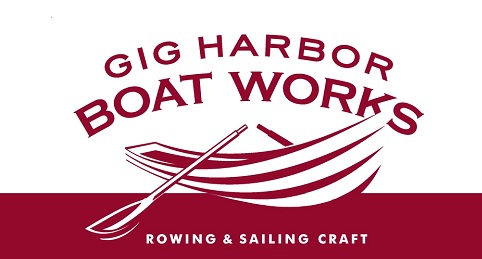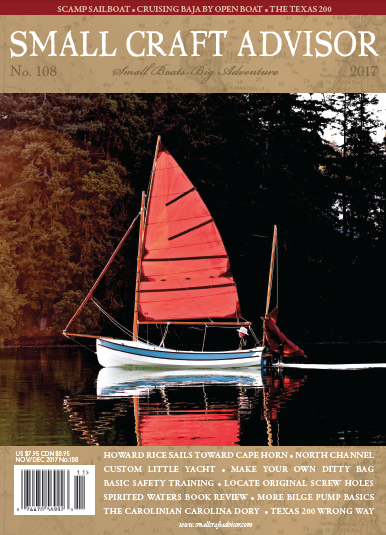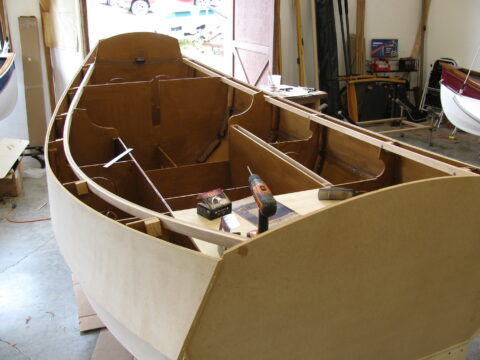Exciting news that’s been a long time coming . . . the Small Craft Advisor magazine released their first formal review of the SCAMP!
For a bit of backstory, the SCAMP, which stands for Small Craft Advisor Magazine Project, was originally conceived by the magazine as a kit boat that would meet the needs of adventurous small craft sailors. It was designed by a team of passionate and knowledgeable small-craft experts that Small Craft Advisor brought together to build something of the “ideal” capable and fun small craft.
You can see how that history might have made Small Craft Advisor hesitant to review a boat of its own design. As the article says, “Given our
involvement with the boat and our predictable biases, we weren’t sure we’d ever publish a formal Review article. However with the passing years and more sailing hours being logged, more owners are available to offer feedback making us confident we can offer a reasonably impartial review of our magazine’s little flagship…”
Our own Falk and Dave were involved in the effort, and we hosted SCAMP events right here in our shop in Gig Harbor as we prepared to adapt the design to fiberglass.
The 6-page review covers the SCAMP as a whole, including both kit-constructed models as well as the fiberglass version made by us here at Gig Harbor Boat Works. It is filled with the personal feedback of both DIY builders and those who’ve purchased our fiberglass boats ready to sail, and it quotes several other press reviews as well.
We’ve republished a few excerpts here – but the whole thing is worth reading. For the full article, please see the check out the Nov/Dec issue of Small Craft Advisor. (Note: the PDF issue is available for purchase here.)
SCAMP Review
This distinctive microcruiser with unusual features has established a cult following
It all started simply enough. We were on a 150-mile cruise down the Columbia River on our 16-foot sailboat and, even though the boat drew only two feet, we kept coming upon even shallower tributaries and backwaters we longed to explore. The perfect boat for this kind of sailing, we thought, was smaller and simpler, rowable, with a flat bottom and skegs so we could take the ground and wait out the tide if we wanted—a boat that would allow us to explore deeper into the tidal zones and along the water’s edge. To camp comfortably we’d want some accommodations—a good sleeping berth, plenty of stowage, and some protection from the elements—but we didn’t want a fully enclosed cabin, which would be claustrophobic on a boat this size and possibly even dangerous. A partial cabin would be better. We also recognized this was a big river and we saw how rough it could get when the wind blew against the current—this little boat would also have to be seaworthy.
Scamp has been called “sneaky fast,” and compared to a bumblebee for flying better than its shape suggests it should. However you want to say it, Scamp’s performance tends to surprise folks.
. . .
While not a planing boat, Scamp does get up to hull speed quickly and, being generously canvassed, will move in just a whisper of wind. At only 11’11” long it won’t keep up with the fastest 15 to 18-footers, but it will literally sail circles around the slower ones.
. . .
Finally, it’s the boat’s extreme maneuverability that might be her best performance feature. With a single sheet and no shrouds or stays, a sailor can put the helm hard over and Scamp will do circles in little more than her hull length, making her quite capable of sailing into marinas or other tight quarters.
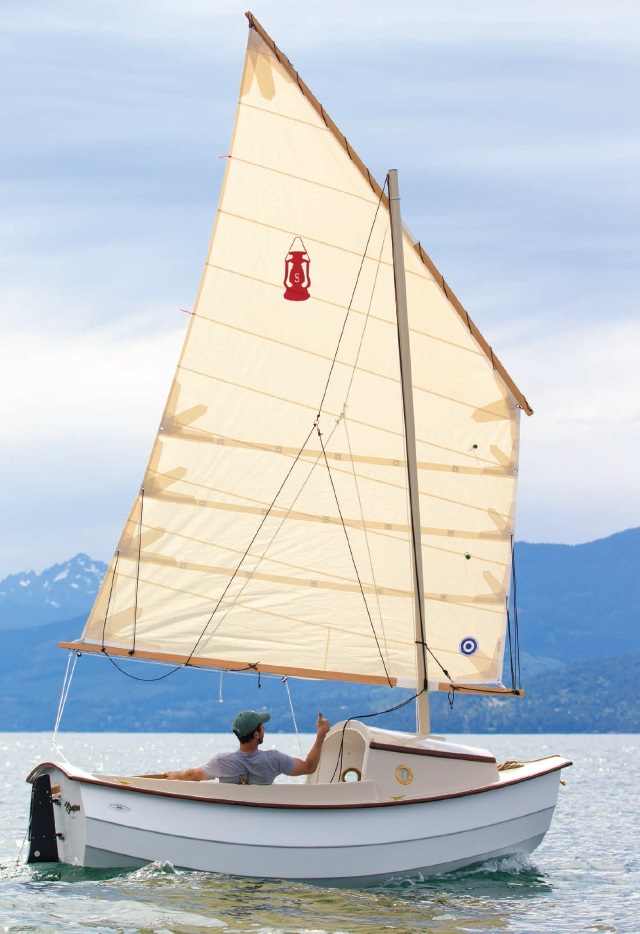
Josh Colvin signals his approval of the prototype
Gig Harbor fiberglass Scamp. Photo by Debra Colvin for Small Craft Advisor.
At 420 pounds empty, Scamp is light enough to be trailered by many smaller 4-cylinder vehicles, and an important corollary is that she’s light enough to reposition on her trailer in a garage, or push her bow off the shore when beached.
. . .
“Have come to really like the simplicity and ease of sailing with the balanced lug sail.” Todd & Jan Sellick, Litle Bark, GH Scamp.
Where a lot of popular trailerable sailboats are not recoverable after capsize, needing a tow or assistance to right and/or pump out, Scamp was designed with self-rescue in mind. In the event the boat is knocked down she will remain afloat and can usually be righted, re-boarded and sailed away—often without needing much or any bailing.
. . .
“Tender to about 10 to 15 degrees then it stiffness up quickly. The boat likes the first reef at 12 to 15 mph winds. The 2nd reef at about 22 mph. Once reefed the boat settles down nicely.” Paul Stovner, Frisky 2015 Gig Harbor Model #367
Few categories are more subjective than sailboat accommodations. Just like with terrestrial camping, where some folks think of backpacks and bivy tents, others imagine motorhomes and microwave ovens. The latter group will find Scamp wanting, but the former will be embarrassed by its excesses.
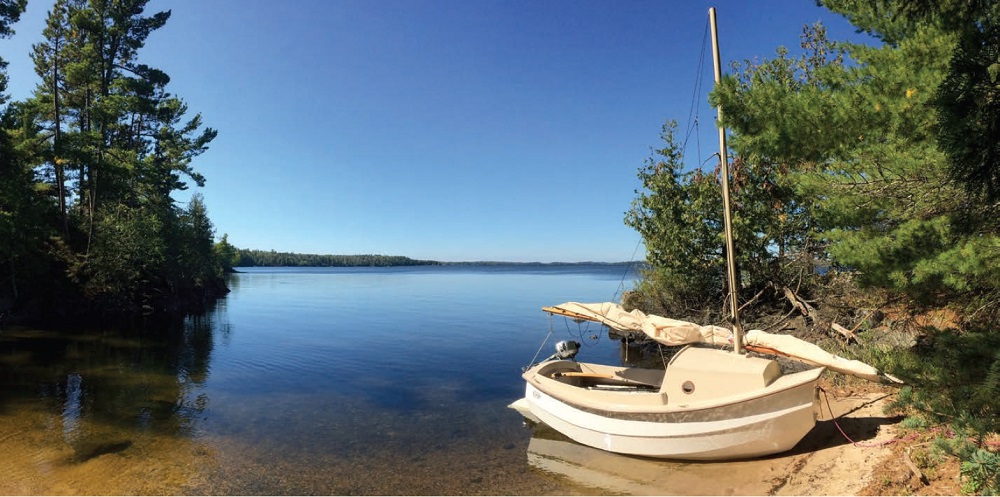
Todd and Jan Sellick’s shot of their ‘glass Scamp Little Bark nosed up to a small island at the east end of Bigstone Bay, on Lake of the Woods, Ontario.
The so-called “glass Scamp” is a perfect match for its wooden sisterships, with no noticeable differences in performance or handling. Certain systems, like the water ballast, lend themselves well to low-maintenance fiberglass construction. Instead of wood, Gig Harbor uses rugged composite materials for things like thwarts and foils.
The Gig Harbor version also employs a two-piece aluminum mast (powder coated in a tan color) that can be broken down for travel stowage. As it’s even lighter than a birdsmouth wooden equivalent, many Scamp builders have opted for the Gig Harbor masts and built their own booms and yards.
. . .
“Very good quality. The boat is two years old and looks new with no gel coat cracks. No issues or failures with the hardware. Very sturdy and ready to take heavy weather. Only flexing is the lower portion backrest coaming in the cockpit. This seems to have no effect on the operation of the boat. No delaminations.” Paul Stovner, Frisky 2015 Gig Harbor Model #367
One question we get now and then is whether someone ought to buy a glass Scamp or build their own. We think the answer is easy: If you’re truly excited about building your own boat and have the time, then go with the kit. If you just like the design and want to go sailing, buy the Gig Harbor model. You’ll probably save money if you build your own, but only if you don’t factor in your time.
. . .
“Very good value, better than a Potter 15 for performance and ease to set up, and more comfortable to sail.” Paul Stovner, Frisky 2015 Gig Harbor Model
Needless to say, SCAMP has surpassed our expectations both as a boat design and in terms of its overall popularity. In addition to proving itself the capable beach-cruiser and backwater explorer we’d imagined, the little boat has inspired adventures, sparked friendships, and drawn new sailors and builders into our small-boat community.
Want to learn more about our fiberglass SCAMP’s creation? Browse through the SCAMP archives!

